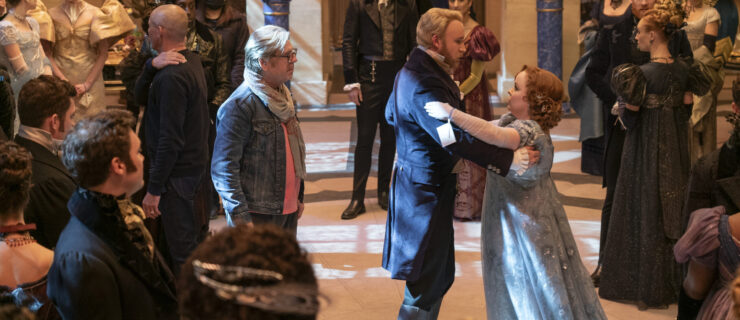Ballet Pantomime

In traditional productions of The Sleeping Beauty, when the evil Carabosse crashes the party celebrating Princess Aurora’s birth, she does not dance. Yet she manages to “say” something pretty complicated: “Your daughter will grow up to be beautiful, but will then prick her finger on a spindle—and die!”
How does Carabosse say all of that without dancing or speaking? Her curse is communicated through a classical pantomime sequence. First pointing to Aurora, Carabosse then places her hand parallel to the floor—low, then a bit higher, then higher still (“She will grow up”); circles her face with her hand (“She will be beautiful”); throws up her hand, with her palm facing out (“But wait!”); points to Aurora again, takes a spindle and pricks her finger with it (“She will prick her finger on a spindle…”); and finally thrusts her arms in front of her, crossed at the wrists (“…and die!”).
“The heart of the ballet’s entire narrative is Carabosse’s conversation about the curse,” says Christopher Stowell, artistic director of Oregon Ballet Theatre, whose staging of The Sleeping Beauty will premiere in October at OBT. “Tchaikovsky [the ballet’s composer] fleshed out the musical theme and left no doubt about the importance of this scene. It requires mime to fully communicate the story, and the gestures must be clear.” In fact, mime is crucial to most classical story ballets.
But where did all the gestures come from? Balletic mime evolved from the pantomime of commedia dell’arte, a form of masked theater that became popular in the mid-16th century. In the early days of ballet, choreographers adopted the mime of the commedia actors—who, since they wore masks, couldn’t talk—to express the things that the dancers, who were also nonspeaking performers, couldn’t say. Eventually these gestures became more elaborate and tailored to ballet, evolving into the specialized vocabulary that we still see today in story ballets like The Sleeping Beauty, La Sylphide, Coppélia and Giselle.
However, by the beginning of the 20th century, ballet was moving away from mimed storytelling. In 1914, choreographer Mikhail Fokine suggested that “conventional pantomime gestures should be eliminated and replaced by significant movements of the entire body.” Just as the steps for the feet had been allowed to evolve, he argued, so should the pantomime.
And pantomime has evolved. Today, choreographers rarely use traditional gestures in their new works—especially since the meanings of those gestures, once commonly known, have become increasingly obscure. (Does the average 21st-century audience member know that swirling one hand around the face means “beautiful”? Probably not!) Choreographer Val Caniparoli has made modern versions of several classic story ballets, including Cinderella. “It is essential for me to work out ways of streamlining mime to avoid confusing the point or over-elaborating,” he says. Though he occasionally uses traditional mime, “usually elaborate gestures aren’t needed. A glance, a shift of the head or an outstretched arm can speak volumes.”
But though many ballets today are abstract, mime remains an important part of a ballet dancer’s education. Not only is it likely that she’ll perform an old pantomime-driven classic at some point, but learning about mime is also rewarding because it helps dancers create richer characters in everything they dance. In his work with ballet companies around the world, Caniparoli has observed that “dancers today want more than just a steady diet of abstractions and endless feats of athleticism and stamina without any soul. Character study and mime training should be part of a dancer’s education—it makes them better actors, and therefore more well-rounded artists.”
Today, pantomime is usually taught to ballet dancers during the rehearsal process by teachers, coaches or character dance experts like San Francisco Ballet master Anita Paciotti. When Paciotti goes into a studio with young dancers or students, she emphasizes that, as in acting, each mimed gesture must be motivated by feelings. “Mime takes cooperation amongst the players; you have to watch each other and be patient,” she adds. The gestures themselves are simple to learn; what takes time and is “hard to get in the studio” is the stagecraft necessary to convey the mime’s message across the theater’s footlights. The key is finding a balance: the motions should be expansive enough to read in the back row but shouldn’t look too cartoonish closer up.
Another reason to study classical balletic mime? It might be making a comeback. “In this art form, as in most, everything happens in waves and cycles,” Stowell says. “Choreographers have been reducing mime for a while now, so it’s due back. We may see a resurgence of mime as an artistic trend soon.”
Basic Mime
Try out these simple pantomime gestures!
Crazy:
Circle your finger around your ear.
Marriage: Point to your left ring finger.
Dance: Raise your arms over your head and circle your hands.
Love: Cross your hands over your heart.
Peter Brandenhoff, a former soloist with San Francisco Ballet, teaches and writes in San Francisco.



